©2001 This email address is being protected from spambots. You need JavaScript enabled to view it.
Go to Sidebar 1, Maintain Temperature Stratification in Your Tank
Go to Sidebar 2, Rust Never Sleeps: Open Loop vs. Closed Loop
Hot water represents the second largest energy consumer in American households. A typical 80 gallon (300 l) electric hot water tank serving a family of four will consume approximately 150 million BTUs in its seven year lifetime. This will cost approximately US$3,600 (at US$0.08 per KWH), not accounting for fuel cost increases. Then it will be replaced by another one just like it. Hmm. Maybe we should rethink this...
An investment in a solar water heating system will beat the stock market any day, any decade, risk free. Initial return on investment is on the order of 15 percent, tax-free, and goes up as gas and electricity prices climb. Many states have tax credits and other incentives to sweeten those numbers even more. What are we waiting for? Forget the stock market. If you have invested in a house, your next investment should be in solar hot water.
In this article I'm going to cover the most common options for solar water heating, basic principles of operation, and some historical perspective on what has worked and what has not.
Below: A Typical Solar Flat Plate Water Heater.
 A Checkered Past, A Bright Future
A Checkered Past, A Bright Future
Solar thermal's past is a good example of why everyone should be skeptical of government involvement in energy. Lucrative federal and state tax credits for solar energy were initiated under President Jimmy Carter in the '70s, and abruptly eliminated under President Ronald Reagan in 1985. This dealt the solar industry a devastating "one-two punch" from which it still has not recovered.
The intention was to stimulate sales for solar thermal systems. But the tax credits resulted in an aggressive promotion of tax credits rather than solar energy. The infant industry was overwhelmed to meet the demand. The demand vanished when tax credits were eliminated, and a majority of solar thermal companies went out of business. Thousands of orphaned solar thermal systems were left behind looking for a service technician.
The solar thermal industry has been purged of the tax credit telemarketers and overnight experts. Today's solar thermal industry includes reliable, efficient products and well-seasoned professionals who have seen it all. Solar hot water is one of the best investments you can make for your house and for the environment.
 First Things First
First Things First
The best savings in hot water come from no cost or low cost options. Before you tackle solar hot water, take these steps:
- Turn the thermostat down. Many water heaters are set to between 140 and 180°F (60 and 82°C). See how low you can go. Try 125°F (52°C) for starters. A hot tub is 106°F (41°C). How much hotter do you need?
- Wrap the water heater with insulation. Insulated water heater "blankets" are usually available where water heaters are sold. (Be careful with natural gas or propane fired water tanks. They use an open flame to heat the water. You need to provide a space for air at the bottom of the tank, and at the top where the flue exits the tank. Safety comes before efficiency!)
- Fix those drips. They may not look like much, but they are a constant and persistent drain on your water heating load, and they waste water too.
- Use flow restrictors and faucet aerators to reduce your hot water consumption.
- Find other ways to use less hot water. Wash only full loads of clothes and dishes.
- Insulate your hot water pipes.
How Large a Solar Hot Water System Do You Need?
Hot water usage in the U.S. is typically 15 to 30 gallons (55-110 l) per person per day for home use. This includes primarily bathing, clothes washing, and dishwashing. But your commitment to efficiency has a lot to do with your actual usage.
Below: A 40 gallon batch heater.
 The hot water tank is usually sized to handle one day's worth of consumption. So for a household of four, it would be reasonable to use an 80 gallon (300 l) tank based on daily hot water requirements of 20 gallons (75 l) per person per day.
The hot water tank is usually sized to handle one day's worth of consumption. So for a household of four, it would be reasonable to use an 80 gallon (300 l) tank based on daily hot water requirements of 20 gallons (75 l) per person per day.
Smitty and Chuck at AAA Solar in Albuquerque have put forth generally accepted rules of thumb for solar thermal collector sizing based on your climatic region:
- In the Sunbelt, use 1 square foot (0.09 m2) of collector per 2 gallons (7.6 l) of tank capacity (daily household usage).
- In the Southeast and mountain states, use 1 square foot of collector per 1.5 gallons (5.7 l) of tank capacity.
- In the Midwest and Atlantic states, use 1 square foot of collector per 1.0 gallon (3.8 l) of tank capacity.
- In New England and the Northwest, use 1 square foot of collector per 0.75 gallon (2.8 l) of tank capacity.
Based on these rules of thumb, a household of four with an 80 gallon (300 l) tank will need approximately 40 square feet (3.7 m2) of collector in Arizona, 55 square feet (5.1 m2) of collector in South Carolina, 80 square feet (7.4 m2) of collector in Iowa, and 106 square feet (9.8 m2) of collector in Vermont.
Of course, these are big ballpark calculations that will be affected by your incoming water temperature, hot water temperature setpoint, actual usage, and the intensity of the solar resource at your site. You should generally expect that this will give you 100 percent of your hot water in the summer and about 40 percent of your hot water year-round.
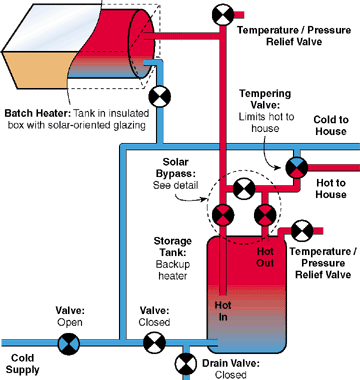 Your Choices–An Overview
Your Choices–An Overview
The type of system you choose will depend mostly on your climate. Freeze-free environments allow for simple, low cost designs. A batch heater uses a storage tank as a collector. A direct pump system circulates water from a collector to a storage tank. A thermosiphon system requires no pump for circulation, just the natural flow of gravity.
Most systems will require some measure of freeze protection. Drainback and closed loop systems with antifreeze and heat exchangers are the best choice for freezing locations. The extra parts increase cost and reduce efficiency, but since one frozen moment can turn into a disaster, it's worth the cost.
Direct pump recirculation systems, which circulate hot water through the collector, are often used where freezing is an infrequent occurrence. That's a risky strategy. Draindown systems, designed to drain water from the collectors to avoid freezing, were the most problematic of system designs. Many were removed or converted. Phase change systems, which in theory could collect heat at night using a refrigerant, never made it into the mainstream of commercial viability. Many of the lessons learned in solar hot water are presented in a publication Solar Hot Water Systems: Lessons Learned, by Tom Lane (see Access).
Solar Batch Heaters
The KISS (keep it simple, stupid) rule applies to solar heating. The batch water heater is the simplest of solar hot water systems. Once affectionately referred to as the breadbox water heater by the do-it-yourself (DIY) community, it has become known as the ICS (integrated collector and storage) water heater in the commercial industry. Its simple design consists of a tank of water within a glass-covered insulated enclosure carefully aimed at the sun.
Cold water, which normally goes to the bottom of your conventional water heater, is detoured to the batch heater first. There it bakes in the sun all day long, and is preheated to whatever temperature the sun is able to provide. Water only flows when used. House water pressure causes the supply of new cold water to flow to the inlet of the batch heater, the lower of the two ports.
Simultaneously, the hottest water exits from the higher port. It flows to the input of the existing water heater, which now serves as a backup to finish the heating job as required. Solar preheated water has become the cold water input to the existing water heater. You save whatever the sun is able to provide. And you still get all the hot water you ask for–it's that simple.
Below: Solar Bypass Valve Configurations.
 Bypass Valves
Bypass Valves
A solar bypass is a series of three valves that allow you to bypass the existing water heater. You can shut it down when the solar collector will do the job alone, such as during summer months or utility blackouts. This is a manually operated configuration; just close off the inlet and outlet valve to the existing tank and open the center valve. This allows hot water to pass directly from the solar batch heater to the house.
Caution! These systems produce very hot water! A tempering valve is your protection from being scalded at the tap. You will regularly see temperatures in excess of 160°F (71°C) in summer months, which is much hotter than you are accustomed to getting from your conventional thermostatically controlled water heater. The tempering valve limits the temperature delivered to the tap by mixing in cold water as necessary.
A pressure temperature relief valve (PTRV) must be installed at the hot water outlet of the batch heater in case temperatures or pressures become excessive. You will find one of these valves installed on every conventional hot water tank too. It is a safety measure required by code. This valve only operates in an emergency, and is often replaced if it opens.
Who Can Use a Batch Heater?
Batch heaters are most appropriate for two to four person households (30 to 40 gallon (110-150 l) daily hot water requirement) in climates where freezing is infrequent. Their size is generally limited because the tank is built into the collector.
Multiple collectors can be installed in series for larger capacities. The outlet of the first collector becomes the inlet of the second in order to deliver higher temperatures. Before you put too many on your roof, consider that a 40 gallon (150 l) batch heater will weigh approximately 500 pounds (225 kg).
Some batch heaters have survived the coldest of winters with freeze-free performance because the large mass of the water tank is quite freeze tolerant. But plumbing lines to and from the tank are very vulnerable. You can make it work with a special selective surface on the tank, a well-insulated, double glazed collector, a whole lot of well-sealed pipe insulation (try R-30 or better), heat tape on the pipe, and good karma.
Are you arrogant enough to tempt Mother Nature to turn your water heater into a frozen fountain? Or are you prepared to drain the collector seasonally? If not, this system is not recommended for climates that freeze regularly.
Separate Collector & Storage
The simple design of a batch heater compromises the effectiveness of collector and storage functions. Heating the whole tank of water all at once will take all day to produce useful temperatures. Once hot, you had better use that hot water at the end of the day before the poorly insulated tank loses its precious heat to the cold night sky.
Most solar hot water system designs separate the collector from the storage tank. This can optimize both functions. Why not bring the tank in from the cold, insulate it well, and leave the collectors out in the sun where they belong?
What are the other advantages of separating the collector from the storage tank? Increase the surface area of a collector, compared to the amount of water being heated, and its temperature will rise more quickly. Configure the storage tank to keep the hottest water apart from the coldest water in the tank and you'll have hotter water available sooner. (See sidebar Maintain Temperature Stratification In Your Tank.)
There are also advantages in freezing climates. By separating the collector from the tank, you can put your tank and piping indoors out of a freezing environment, and insulate them better for greater efficiency.
Below: Two roof-mounted flat plate collectors.
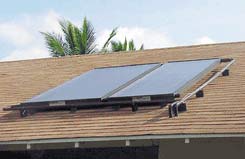 Flat Plate Collectors
Flat Plate Collectors
Flat plate collectors are the most common solar thermal collectors. They are most appropriate for low temperature applications (under 140°F; 60°C), such as domestic hot water and space heating.
A flat plate solar thermal collector usually consists of copper tubes fitted to a flat absorber plate. The most common configuration is a series of parallel tubes connected at each end by two pipes, the inlet and outlet manifolds. The flat plate assembly is contained within an insulated box, and covered with low-iron, tempered glass. (See the diagram on page 45.)
The most efficient collector design maximizes solar heat gain, minimizes heat losses, and provides for the most efficient heat transfer from absorber plate to tube. Operating temperatures up to 250°F (121°C) are obtainable, although neither common nor desirable. Remember, you want hot water, not steam.
Selective Surface
A selective surface, often referred to as "black chrome" is far more efficient than a black painted absorber surface. Although a black surface is most efficient at absorbing solar radiation and converting it to heat, it is also highly efficient at re-radiating long wave infrared heat back out. These losses reduce collector efficiency.
A highly polished chrome surface would re-radiate the least infrared heat energy, but of course not being black, it would absorb very little. A selective surface combines the best of both worlds; high absorptance with low emittance. Sound high-tech? It's been around since the 1950s, and is used on most commercially available flat plate collectors. Its performance is worth the marginal additional cost, particularly in cold climates where radiant heat loss is greatest.
Below: A Thermomax evacuated tube collector.
 Evacuated Tube Collectors
Evacuated Tube Collectors
If you want the highest efficiency solar thermal collector, you'll be interested in an evacuated tube collector, such as the one manufactured by Thermomax. Although evacuated tube collectors are more efficient than conventional flat plate collectors, they cost approximately twice as much per square foot.
Each tube and fin of the collector is contained within a glass tube from which all the air has been evacuated. Why? Air carries heat from the hot surface of the tube to the cooler surface of the glass to accelerate heat loss by convection. Eliminate the air and you have eliminated convective heat loss.
To minimize radiant heat loss, the tube is covered with a selective surface. Evacuated tube collectors are most appropriate for high temperature applications (over 140°F; 60°C). They are useful for more common low temperature applications too, such as domestic water and space heating.
Below: Direct Pump Recirculation System.
 Collector to Tank Interface
Collector to Tank Interface
With the collector and the storage tank separated, the system design must provide a flow of water (or antifreeze) from tank to collector and return. Small circulating pumps provide the necessary flow with very modest energy requirements. Small hot water systems may use a direct current (DC) circulating pump powered by a single PV module (10 to 30 watts depending upon power requirements). You may be able to do without the pump altogether if you design for natural thermosiphon flow.
Thermosiphon System:
Natural Flow Powered by Gravity
Gravity powers convective flow in a thermosiphon system. Water in the collector becomes buoyant as it is heated, and it rises to an elevated tank. Cooler, heavier water falls from the tank to take its place. For best results, place the top of the collectors at least one foot (30 cm) below the bottom of the tank. Greater height differential will result in greater flow. Larger pipe, shorter runs, and gentle bends will make for an adequate flow rate.
If you require freeze protection, it's not hard to do. The collectors can be filled with an antifreeze solution (propylene glycol is the most common). The heat can be transferred to the domestic water via a heat exchanger.
Direct Pump Recirculation
The direct pump system uses an electric circulating pump to move heat from the collector to the storage tank. This means that you are free from the constraint of placing the collector below the tank, as required for thermosiphon flow. The pump can move heat from the collectors on the roof to a storage tank in the basement. Good sense still calls for minimal length of pipe run for efficiency.
A differential controller turns the circulating pump on or off as required. There are two sensors, one at the outlet of the collectors, and the other at the bottom of the tank. They signal the controller to turn the pump on when the collector outlet is 20°F (11°C) warmer than the bottom of the tank. It shuts off when the temperature differential is reduced to 5°F (2.8°C). Some systems let you adjust this hysteresis.
Below: Closed Loop Antifreeze Heat Exchanger System.
 In climates where freezing occurs infrequently, a recirculation-type differential control will turn the circulating pump on when the collector inlet temperature falls to 40°F (4.4°C). The philosophy behind this design is that the cost of heating your collectors with hot water from your tank is low cost freeze protection if only required occasionally.
In climates where freezing occurs infrequently, a recirculation-type differential control will turn the circulating pump on when the collector inlet temperature falls to 40°F (4.4°C). The philosophy behind this design is that the cost of heating your collectors with hot water from your tank is low cost freeze protection if only required occasionally.
These systems were commonly used in the sunbelt, and only where freezing is a rare occasion. Recirculation systems are no longer very commonly used due to vulnerability to freezing as a result of power outages, malfunction of sensor or controller, or damaged sensor wires.
Draindown System (Not Recommended)
A draindown system is an open loop system in which the collectors are filled with domestic water under house pressure when there is no danger of freezing. Once the system is filled, a differential controller operates a pump to move water from the tank through the collectors.
A draindown valve, invented in the 1970s exclusively for these systems, provides the freeze protection function. When the collector inlet temperature falls to 40°F (4.4°C), the draindown valve, activated by the controller, isolates the collector inlet and outlet from the tank. It simultaneously opens a valve that allows water in the collector to drain away. A vacuum breaker is always installed at the top of the collectors to allow air to enter the collectors at the top so water can drain out the bottom. Right next to the vacuum breaker, you'll find an automatic air vent to allow air to escape when the system fills again.
Draindown systems have proven to be the most problematic of all freeze protection systems. They are vulnerable to frozen vacuum breakers and air vents, damaged sensors or wiring, lack of proper pipe drainage, and malfunctions with the draindown valve. This type of system is rarely installed new any more, and is not recommended. Many were converted to drainback or closed-loop antifreeze systems.
Closed Loop Antifreeze Heat Exchanger
Closed loop antifreeze systems provide the most reliable protection from freezing. These systems circulate an antifreeze solution through the collectors and a heat exchanger. Propylene glycol is the most common antifreeze solution. Unlike ethylene glycol (used in automobile radiators), propylene glycol is not toxic.
The closed loop antifreeze systems generally have the most parts. You'll find an expansion tank to allow the antifreeze to expand and contract with temperature change. You'll find a pressure relief valve to protect against excessive pressures in the closed loop; a spring-loaded check valve to prevent reverse flow of the closed loop at night so the collectors won't dissipate the heat from the water heater; an air vent and/or air eliminator to help get the air out of the closed loop (air is your enemy–it can block fluid flow through the system); and a pressure gauge so you can tell if your system is still charged. A couple of temperature gauges are a good idea in any system so you can tell how well your system is operating.
There's also one more assembly of fittings. Two boiler drains with a shutoff valve in between will allow you to charge the system with your charging pump. Once ready to charge the closed loop with your antifreeze solution, a charging pump is used to circulate the fluid throughout the loop, expelling all the air in the process.
Closed loop systems like this are quite common, whether they be for solar domestic hot water, radiant floor heating, or hydronic baseboard heating. Despite the many additional parts and fittings, they have a high degree of reliability, and are well understood by heating contractors.
Below: Closed Loop Drainback System
 There is a downside to the closed loop antifreeze system design. Once a solar water heating system has satisfied its daily responsibilities, the system stops circulating. Without circulation to remove heat from the collectors, temperatures can climb to as high as 400°F (204°C).
There is a downside to the closed loop antifreeze system design. Once a solar water heating system has satisfied its daily responsibilities, the system stops circulating. Without circulation to remove heat from the collectors, temperatures can climb to as high as 400°F (204°C).
These high stagnation temperatures, as they are called, can cause problems with air pockets and breakdown of glycol antifreeze solutions. Air pockets form because high temperatures drive dissolved gases out of solution. Systems using propylene glycol as the antifreeze may use an inhibitor additive to prolong the life of the glycol. Otherwise, the glycol can break down, resulting in a sludgy deposit. Silicon and hydrocarbon oils have been used to avoid these problems, but they are expensive and are incompatible with seals and gaskets found in most off-the-shelf components.
Drainback: A Simpler Closed Loop
Although similar in name to the draindown type system, the drainback system is far different and much more reliable. It also provides some advantages over the closed loop antifreeze system. Drainback systems may use water as the heat transfer fluid, since the collectors drain when not in operation. Antifreeze provides an extra measure of freeze protection from poor drainage and controller or sensor malfunctions.
A circulating pump operated by a differential control is turned on when the collector outlet is at least 20°F (11°C) warmer than the tank outlet. Water or an antifreeze solution is lifted from a small reservoir tank and circulated through the collectors and back to the tank. Heat is transferred to the domestic water via a heat exchanger in the reservoir tank. The circulation loop through the collectors is a closed loop. The water or antifreeze solution is installed at the time of installation, and does not present a recurring supply of oxygen.
A drainback system requires a larger pump than any of the other systems described here. It must have sufficient capacity to lift the fluid to the highest point in the system. When there is no more heat to be collected, the controller turns the pump off, and all the fluid drains back to the reservoir tank. The collectors are empty. They can't freeze, and they can't overheat the antifreeze. As a DIY homeowner, you won't need a special charging pump either. When it comes time to change the antifreeze, you can just drain and refill the reservoir tank.
Solar Hot Water System Types: Advantages & Disadvantages
| System Type |
Characteristic & Use |
Advantages |
Disadvantages |
| Solar Batch Water Heater |
Open loop; Integrated collector & storage; Freeze protection generally limited to infrequent or light freeze climates |
Simple; No moving parts |
Freeze protection typically poor; Inefficient in cold climates; Small systems only |
| Thermosiphon |
Typically open loop; May be closed loop with heat exchanger & antifreeze |
Simple; Requires no electricity for operation |
Collector must be located below tank; Inappropriate for use with hard water (open loop system) |
| Direct Pump System |
Open loop; Freeze-free climates |
Flexible placement of tank & collector; can be powered by PV |
No freeze protection; Inappropriate for use with hard water |
| Direct Pump Recirculation System |
Open loop; Climates where freezing is an unexpected occasion |
Simple; can be powered by PV |
Freeze protection is limited to infrequent & light freezes; Inappropriate for use with hard water |
| Draindown |
Open loop; Designed to drain water when near freezing |
Can be powered by PV |
Freeze protection is vulnerable to numerous problems; Collectors & piping must have adequate slope to drain; Inappropriate for use with hard water |
| Closed Loop Heat Exchanger |
Closed loop; Cold climates |
Very good freeze protection; Basic principles well understood by conventional plumbing trades; No problems with hard water; can be powered by PV |
Most complex of all systems, with many parts; Heat exchanger & antifreeze reduce efficiency; Fluid may break down at high stagnation temperatures |
| Drainback |
Closed loop; Cold climates |
Very good freeze protection if used with antifreeze; No problems with hard water; Simplest of reliable freeze protection systems; Fluid not subject to stagnation temperatures; Simple to homebrew; can be powered by PV |
Heat exchanger & antifreeze reduce efficiency; Collectors & piping must have adequate slope to drain; Requires larger pump to lift |
The Choice is Yours
The system you choose will be determined first by whether you need freeze protection. If you live in a freeze-free climate, choose a batch heater or small thermosiphon unit for small systems serving one to three people. Larger needs can be met with an open loop direct pump system circulating water from storage tank to flat plat collector.
If you need freeze protection or have hard water, choose one of the closed loop systems with antifreeze and a heat exchanger. Either one will heat your water without fear of freezing.
Solar hot water is a good investment. Whether you are a do-it-yourselfer with plumbing skills or want hire a professional installer, I suggest you locate a dealer who serves your area. Ask their professional advice. Find out the products and services they have to offer, and which is the best fit for your needs and climate. Contact the American Solar Energy Society or the Solar Energy Industries Association for assistance in locating a contractor or supplier in your area.
Back to top
Sidebar 1
Maintain Temperature Stratification in Your Tank
Hot water returning from the collector should enter the storage tank about a third of the way down from the top. This water may not be the hottest water you have collected all day, because solar insolation and outside ambient temperatures vary during the day. You don’t want this water to disturb the water at the very top of the storage tank. Draw water for use from the very top of the tank. That is where it’s the hottest.
When hot water is drawn from the tank, it is replaced by new cold water, which should enter at the very bottom. Water circulating to the solar collector should be drawn from the bottom of the tank. Why? Efficiency! Always supply your collector with the coolest water you have available. The cooler a solar collector runs, the less heat it loses to the surrounding environment.
Back to top
Sidebar 2
Rust Never Sleeps: Open Loop vs. Closed Loop
A “hydronic” system is one that uses a liquid as its heat transfer medium. The most common alternatives to hydronic systems are air systems. Hydronic systems are nearly always categorized as “open loop” or “closed loop”—often referred to as “direct” or “indirect” respectively. If you are not aware of the difference between these, you run the risk of discovering one day that your system has been eaten alive by a slow yet persistent killer—oxygen.
Open Loop
Open loop systems are subject to a periodic fresh supply of oxygen, ready to trash every bit of cast iron, steel, or other corrodible part in your system. Whenever you draw water at the tap or bath, new water simultaneously moves in to replace it. Along with that new water comes a fresh supply of oxygen.
You have two lines of defense against damage by corrosive oxygen. You can prevent oxygen from entering the system, or you can use materials that are resistant to corrosion. Copper, bronze, brass, stainless steel, plastic, and the glass lining of a hot water tank have no problem with oxygen. Use these materials when dealing with fresh water supplies associated with “open” or “direct” systems.
Closed Loop
If your system is a “closed system,” you won’t have to worry about oxygen. You will be able to use cast iron components (pumps), which can save you money. Closed systems are charged with fluid at the time of installation. As a permanent part of the installed system, new oxygen is not introduced, and corrosion is not a problem. Read on and you will see several examples of open and closed systems.
Another important consideration with open or direct systems is whether or not you have hard water. Over time, calcium deposits from hard water will clog the collectors, ruining them. These deposits can be removed with periodic use of a descaling solution. But if you have hard water, you’ll be better off with a closed loop system.
Back to top
Access
Ken Olson, SoL Energy, PO Box 217, Carbondale, CO 81623 · Fax: 559-751-2001 · This email address is being protected from spambots. You need JavaScript enabled to view it. · www.solenergy.org
AAA Solar Supply Inc., 2021 Zearing NW, Albuquerque, NM 87104 · 800-245-0311 or 505 243-4900 · Fax: 505-243-0885 · This email address is being protected from spambots. You need JavaScript enabled to view it. · www.aaasolar.com · For more design and schematic detail click on "Design Guide" then "Hot Water."
Thermo Technologies, 5560 Sterrett Pl., Suite 115, Columbia, MD 21044 · 800-7SOLAR7 or 410-997-0778 · Fax: 410-997-0779 · This email address is being protected from spambots. You need JavaScript enabled to view it. · www.thermotechs.com · Thermomax evacuated tube collector
American Solar Energy Society, 2400 Central Ave. G-1, Boulder, CO 80301· 303-443-3130 · Fax: 303-443-3212 · This email address is being protected from spambots. You need JavaScript enabled to view it. · www.ases.org
Solar Energy Industries Association, 1616 H St. NW, 8th Floor, Washington, DC 20006 · 202-628-7745 · Fax: 202-628-7779 · This email address is being protected from spambots. You need JavaScript enabled to view it. · www.seia.org
Tom Lane, Energy Conservation Services of North Florida Inc., 6120 SW 13th St., Gainesville, FL 32608 · 352-377-8866 · This email address is being protected from spambots. You need JavaScript enabled to view it. · www.ecs-solar.com
 ©1995 - 2001 Home Power magazine. All rights reserved.
©1995 - 2001 Home Power magazine. All rights reserved.
These presentations are a good introduction:
Passive Solar Energy ASC PowerPoint 4.pptx
Passive Solar Energy ASC PowerPoint 4.pdf
View Passive Solar Energy ASC PowerPoint 4 as Slide Show
Solar Energy Overview as a PowerPoint - 125 slides (requires PowerPoint viewer)
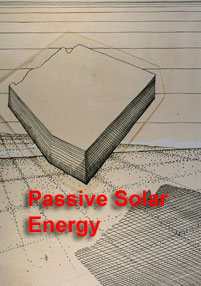
The sun’s energy is an incredible bounty. The energy contained in solar rays make their way through our filtering atmosphere and is critical to life on this planet and is fundamental to human survival. It can also provide for our comfort.
The use of the sun’s power in solar energy design is usually identified in 2 contexts - Passive Solar - that which uses natural processes without mechanical equipment and additional electrical or gas energy to operate, and Active Solar - that which uses nature’s resources with the inclusion of mechanical equipment and hardware driven by electricity and gas.
All solar design starts from a simple base - Passive Solar First.
What can be achieved by using all of the natural resources available to meet specific needs? This is the basic question and tenet of Passive Solar applications whether it be applied to heating and cooling a building, lighting, heating water, cooking, etc. Passive solar applies both to buildings and equipment.
Sound fundamentals of good passive applications and integration can beneficial and are directly related to active solar equipment use and implementation:
-
by meeting needs with no mechanical equipment dependent on external energy incorporation,
-
in improving conditions which reduce the amount and size of equipment required to meet needs,
-
by improving the conditions for active solar equipment applications, and
-
in minimizing the commensurate costs that accompany the purchase and use of any equipment, solar or non-solar.
In short , Passive solar design and applications is the base which sets the conditions for effective active solar incorporation and use.
 Passive and Active solar applications should be considered as elements of the same palette - sort of the one-two punch of living with the sun,and the mutuality is undeniable. Both rely on the same design considerations of orientation, access to the sun, behavior of materials, and appropriate use of site resources, and vary only in the inclusion external energy of electricity and gas. Most active system guidelines even point out starting with passive considerations first.
Passive and Active solar applications should be considered as elements of the same palette - sort of the one-two punch of living with the sun,and the mutuality is undeniable. Both rely on the same design considerations of orientation, access to the sun, behavior of materials, and appropriate use of site resources, and vary only in the inclusion external energy of electricity and gas. Most active system guidelines even point out starting with passive considerations first.
Besides providing for direct meeting of needs, Passive Solar design is a primary basis for enhancing the quality of active solar systems. Passive solar actions can result in the reduction of quantity of equipment needed to meet a particular task. For example, daylight is an available resource to meet illumination needs. Good day lighting design of buildings uses that resource effectively, and reduces the need and cost of daytime artificial lighting and equipment.

The beginning point consideration is at the end use side of things whether using traditional equipment or using solar equipment. Considerable savings can be gained in applying natural energy actions to reduce the cost of both supplying equipment as well as running and maintaining it. Quite simply, the less work that needs to be accomplished by equipment, the less amount of equipment is needed, and the less it needs to run when used - this all translates to less cost for purchase of the equipment, and less on-going cost for running and maintaining. Passive solar applications mitigate the quantity of active solar equipment needed, and resulting the tandem of both is optimal. Information about the sun and how to use it effectively is common in both applications.
 Traditionally, the term Passive Solar has been identified with heating and cooling of buildings, but it has a broader context and application. There is, of course passive solar heating and cooling of buildings. There is also passive solar water heating, solar cooking, natural lighting, passive solar heating of pools, and even passive solar devices which move things - equipment, air, etc. Even the process of direct conversion of sunlight to electricity can be considered a “passive” action since it occurs through the appropriate use and placement of materials and capitalizes on the behavior of the combinations created, without infusing man-made energy sources and machines to make it work.
Traditionally, the term Passive Solar has been identified with heating and cooling of buildings, but it has a broader context and application. There is, of course passive solar heating and cooling of buildings. There is also passive solar water heating, solar cooking, natural lighting, passive solar heating of pools, and even passive solar devices which move things - equipment, air, etc. Even the process of direct conversion of sunlight to electricity can be considered a “passive” action since it occurs through the appropriate use and placement of materials and capitalizes on the behavior of the combinations created, without infusing man-made energy sources and machines to make it work.
Knowledge and understanding of natural processes is the heart of Passive Solar. Knowledge about the composition, attributes and behavior of sunlight and heat; the behavior of heat flow; the behavior and capacities of materials, both in nature and man-made; the sun’s annual, seasonal, and daily movement; diurnal and seasonal temperatures and conditions; human sensory response and comfort ; the patterns of nature and of people; and the physiology and psychology of the interaction between people and Nature, all are applied to effective solar application and utilization.
PASSIVE SOLAR

NATURE’S CONTRIBUTION - a gift that also keeps us on our toes


intense heat, cold) The conditions that nature provides, in the form of climate, is variable. Cold in the winter, hot in the summer, nice other times of the year. Arizona climate covers the entire spectrum with extremes at the desert and mountain locations. Simultaneously, nature also provides the tools for mitigation of the extreme conditions. Sunlight and materials for a warming system; breezes, water, earth, gravity, and materials for a cooling system. It is the application of these resources into a system that addresses conditions that makes passive, and active, solar so effective.


The sun’s available energy varies in amount and impact through the year. The amount and intensity of energy from the sun that impacts the earth is affected by the composition of the earth’s atmosphere, and the angle of the solar radiation waves. The more dense the atmosphere, whether by clouds or smog, the less solar energy reaches the ground. Additionally the more directly perpendicular the sun is to the earth’s surface, the more concentrated the energy is in a given area and the more intense its impact. The highest capitalization of solar radiation for heat is when surfaces are perpendicular to the sun, allowing the most density of radiation at a given point.
 We know the sun’s position every day of the year and the amount of radiation that position provides, both to the earth’s surface, as well as to various positions of building walls and/or equipment. A south facing wall, or piece of equipment gets more energy from the sun than any other position. An angle directly perpendicular to the sun gets more energy per square foot than one that is at an angle. The sun is less available in the winter (shorter days) than in the summer. There is less solar energy availability in the winter than the summer due to the sun’s position at an angle to the earth and therefore more atmosphere to penetrate.
We know the sun’s position every day of the year and the amount of radiation that position provides, both to the earth’s surface, as well as to various positions of building walls and/or equipment. A south facing wall, or piece of equipment gets more energy from the sun than any other position. An angle directly perpendicular to the sun gets more energy per square foot than one that is at an angle. The sun is less available in the winter (shorter days) than in the summer. There is less solar energy availability in the winter than the summer due to the sun’s position at an angle to the earth and therefore more atmosphere to penetrate.
We also know that cool air settles and warm air rises, and that this action occurs with fluids like water. We know about heat flow and capabilities of materials in their capacity to absorb, hold, and give up heat. We know how to let sunlight in, how to capture and create air movement for cooling, and prevent unwanted heat.
THE BUILT ENVIRONMENT IN TUNE WITH NATURE
 Passive solar buildings are environmentally responsive and use nature’s elements in providing shelter and comfort to people in a manner that is healthy and minimally destructive of the environment; are non-depleting of natural resources; and use the building itself in the comfort creating process. They are characterized throughout the recent years with terms as “sustainable”, “renewability”, and “green”. Quite simply, these terms refer to the same thing - a nature incorporating , comfort generating, security providing environment in which the building composition itself is the “machinery” that creates protection, health and comfort, and incorporates appropriate solar equipment to attain higher degrees of performance.
Passive solar buildings are environmentally responsive and use nature’s elements in providing shelter and comfort to people in a manner that is healthy and minimally destructive of the environment; are non-depleting of natural resources; and use the building itself in the comfort creating process. They are characterized throughout the recent years with terms as “sustainable”, “renewability”, and “green”. Quite simply, these terms refer to the same thing - a nature incorporating , comfort generating, security providing environment in which the building composition itself is the “machinery” that creates protection, health and comfort, and incorporates appropriate solar equipment to attain higher degrees of performance.
HISTORY
Arizona history is replete with examples of people living with the sun - both in using it as a resource as well as dealing with it’s negatives. Passive solar was integrated into Arizona architecture and buildings, both in private and public buildings. While incorrectly called Arizona’s first solar building, (there is no indication that this was a conscious effort since a number of cliff dwellings built in the same period by the same people do not show the same kind of solar application) the construction of Montezuma’s Castle does embody some solar principles of orientation, thermal mass, “overhangs” for summertime shading, and south facing winter courts



Desert buildings used proper orientation, thick masonry walls, natural cross ventilation, indoor and outdoor living spaces, and natural and man-made shade for summer cooling, and south facing courts, and windows with tile floors which, when coupled with the thick masonry walls, provided for capture and storage of warmth during winter conditions. Higher elevations of Arizona utilized the similar principles with differing amounts of wall mass and windows for heating, and porches and cross ventilation for summer evening relaxation and sleeping.
 Arizona desert buildings, both private and public, used passive means of shading to provide respite from the intense sun. Passive solar equipment, in the form of water heaters, were prevalent in Arizona as well as Southern California. the historic Ellis-Shackleford House in Phoenix and the historic Tempe Bakery had direct gain solar hot water heaters.
Arizona desert buildings, both private and public, used passive means of shading to provide respite from the intense sun. Passive solar equipment, in the form of water heaters, were prevalent in Arizona as well as Southern California. the historic Ellis-Shackleford House in Phoenix and the historic Tempe Bakery had direct gain solar hot water heaters.
PASSIVE SOLAR ENERGY - PRELUDE TO SOLAR EQUIPMENT CONSIDERATION
There are a number of passive energy fundamentals which can be considered in reducing the amount of equipment and/or its’ operation.
ORIENTATION - It’s a necessary thing...

Like all direct solar applications, capturing the sun as a resource is as simple as providing for its clear path to where it can do its work - be it heating water, cooking food, or warming a space. Orientation is a fundamental concept of solar use for passive, and active, systems -



orientation of a solar device or orientation of a building or a solar cooker
Orientation and a direct relationship with the sun is the first rule of solar energy use when trying to capitalize on its heat providing attributes. The sun’s traverses the sky every day -
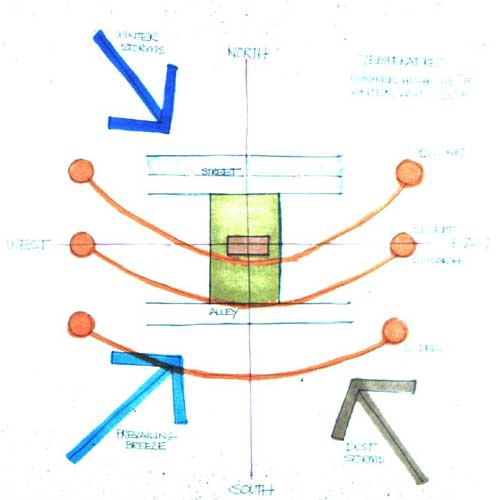
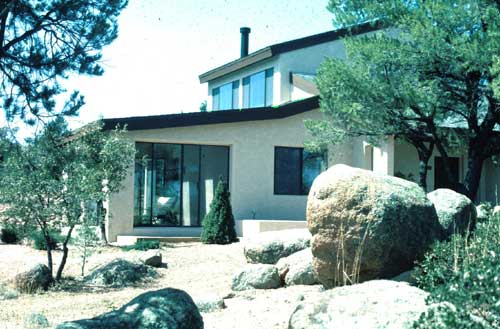
In the winter it is a low and short path and in the summer a long and high path - and even though the sun’s location is constantly changing, it is a predictable path that can be used in incorporating the sun’s energy to meet needs, and to exclude when we want to minimize the same. Applied knowledge of both the sun’s movement, position at any given time, and time of the year, as well as impact in the form of radiation (solar incidence) , enables us to take advantage of these attributes to meet needs, and to make use of our buildings and our equipment more effective and efficient.
Proper orientation is critical to optimizing the solar resource. A properly oriented building can optimize solar gain for human comfort heating, and with proper shape and overhangs can minimize summertime overheating. Likewise, properly oriented solar equipment, be it a solar water heating panel or a photovoltaic electricity generating panel, will have optimum production and minimal negative impact. Using natural winter heating and minimizing summer heat impacts reduces the size of heating and air conditioning equipment as well as the energy, traditional or photovoltaic, needed to provide energy to these systems. Additionally, proper orientation allows for full benefit of the operation of electric solar panels and maximizing solar water heating operations.
Proper building orientation also eases the integration of active solar equipment into the building form and shape, and mitigates the conflicts of solar installations contested in numerous subdivisions regulations.
Proper orientation with direct exposure to the south, is best for passive solar heating of building spaces as well as the operation of solar equipment (water heaters, PV panels, cookers, pool panels, etc.). slight adjustments to the east or west of south allow for earlier or later use of the sun's energy, or for mitigating it.
FORM - It’s a right thing
 Solar buildings employ a form and shape that is responsive to the elements of nature that impact upon it, as well as the solar equipment that is part of the passive/active solar approach. Elongated along the east west axis, an Arizona building optimizes the southern exposure for good wintertime direct heating, while minimizing the east and west exposures which are severely impacted negatively in the summer, especially in the Arizona desert areas. Good building form is also beneficial when it comes to integration of solar equipment. Instead of unsightly racks, collector panels can be blended into the building architecture, and seem as seamless as a skylight or clerestory window.
Solar buildings employ a form and shape that is responsive to the elements of nature that impact upon it, as well as the solar equipment that is part of the passive/active solar approach. Elongated along the east west axis, an Arizona building optimizes the southern exposure for good wintertime direct heating, while minimizing the east and west exposures which are severely impacted negatively in the summer, especially in the Arizona desert areas. Good building form is also beneficial when it comes to integration of solar equipment. Instead of unsightly racks, collector panels can be blended into the building architecture, and seem as seamless as a skylight or clerestory window.
For this reason roof design is important re: slopes and orientations to the sun’s path. (slide 28) Equally important is the integration of passive solar strategies to building additions such as thermal chimneys to accelerate cross ventilation, cooling towers, and north facing clerestories which incorporate hot water and PV panels on their back sides.
LOCATION - It’s the effective thing
 Location of a building and the placement of the spaces within are a critical passive element in optimizing the use of natural resources for comfort, and proper placement also optimizes integrated solar equipment by minimizing piping runs and complex plumbing and electrical transfers. 90% of the winter sun’s energy is received at the earth’s surface between 9 a.m. and 3 p.m. so open and continued exposure is important for natural heating. Habitable spaces that benefit from solar heating are best located on the south side of a building with support spaces (garage, storerooms, etc.) located to the perimeter and to the north side. In this way the sun can directly, or indirectly, provide it’s energy to warm the spaces which means less heating equipment.
Location of a building and the placement of the spaces within are a critical passive element in optimizing the use of natural resources for comfort, and proper placement also optimizes integrated solar equipment by minimizing piping runs and complex plumbing and electrical transfers. 90% of the winter sun’s energy is received at the earth’s surface between 9 a.m. and 3 p.m. so open and continued exposure is important for natural heating. Habitable spaces that benefit from solar heating are best located on the south side of a building with support spaces (garage, storerooms, etc.) located to the perimeter and to the north side. In this way the sun can directly, or indirectly, provide it’s energy to warm the spaces which means less heating equipment.
Additionally, ancillary spaces located to the perimeter east and west sides provide a thermal barrier zone to the habitable spaces, thereby reducing the heating and cooling loads to an easily manageable level. Proper orientation and spatial design allows for optimum use of the sun for providing thermal comfort in both winter and summer, and reduces the amount of heating and cooling equipment, as well as the energy required to run it. Additionally, proper location can reduce the amount of solar equipment needed in a radiant floor system and/or for PV systems which provide power to air conditioning and heating machinery.
 Good location planning extends to the integration of solar equipment as a building component by reducing piping runs and the commensurate “line losses” , thereby allowing more of the solar heat captured in a water heating system to get to the storage and/or use point.
Good location planning extends to the integration of solar equipment as a building component by reducing piping runs and the commensurate “line losses” , thereby allowing more of the solar heat captured in a water heating system to get to the storage and/or use point.
MATERIALS - It’s the smart thing:

All solar heating and cooling systems are based on the ability to gather and store solar energy within a material for a period of time. This is accomplished by using a material which will hold heat until it is needed for heating, or capturing heat that will be dispelled at a later time. Solar water heaters use water. Solar buildings use their own structure - floors, walls, even roofs. Of course, some materials are better for this purpose than others. Glass, wood, and insulation are not good holders of heat. More dense materials like earthen materials (adobe, stone, brick, etc) and man-made materials like concrete are very good. This attribute is called thermal mass.
Heating application of thermal mass is to select material(s) that will absorb heat from solar exposure during the day, hold that heat for a time during non-solar periods, then give it up as conditions warrant. The same action can be incorporated for building cooling. As an area heats up, heat can be absorbed into the thermal mass material in the walls, floor or ceiling, like a thermal sponge, then held until evening time where effective cooling practices using cross ventilation, night sky radiation and even whole house mechanical ventilation (remember - nighttime electricity rates are lower than daytime). This action is based upon fundamental principles of thermal transfer.
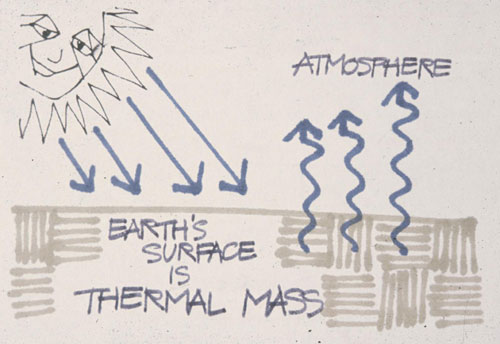
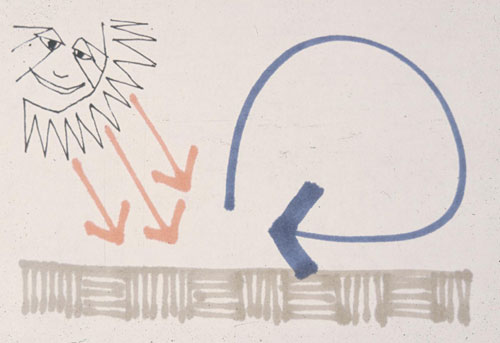
Nature is always seeking to even out things so if there is a “difference”, there is a natural action which moves to make every thing the same or to even out. In the case of heat transfer, heat migrates to cold, so in a building, hot walls will radiate into cold spaces, and conversely, hot, summertime spaces will have their heat migrate to cooler walls. An analogy that has been used is one of 2 buckets of water - 1 full and one empty. If they are placed at an equal height, and there is a connection between the 2, below the water line of the first, water will flow to the second until there is an equal amount in the second where all action will stop because a balance has
been achieved.
Passive solar buildings utilize the very fabric of the building as part of the comfort system for heating and cooling, and the addition of active solar system for running naturally heated or cooled water to through a thermal mass wall, floor, or roof structure enhances the performance of the system by the additional thermal mass capacity and heat capture/transfer attributes of the
water.
WINDOWS - It’s the clear thing.
 +
+ >>
>> 

One of the major design considerations affecting a building’s energy consumption is the location and size of windows. Windows are the weakest point of the building envelope and usually the leakiest when it comes to energy, both in terms of losing heat in the winter, and gaining heat in the summer. A square foot of glass will lose 12 time more energy than a wood wall with insulation. As a rule, windows should be located primarily on the south side where they can be used as part of the heating system, as well as provide for natural lighting. That is the side where the sun is!. East and west sides of desert buildings should have minimal or no windows since these are the 2 worst exposures for early morning and late afternoon summer sun. East windows allow for early summer morning heat up and west windows allow for late afternoon negative impacts.
Solar windows should be sized in accordance with the heating and cooling performance of the building. Typical oversizing to have the “feel of the great outdoors” is not an optimal situation when it comes to solar design.
Clerestorey windows are a design tool for getting sunlight benefits (heating and lighting) to areas not able to be located at the south face. Clerestories also provide a mechanism for diffusing the direct impact of sunlight and moderating glare. Additionally, operable clerestorey windows are a good device for house ventilation cooling in the summer.
Reverse clerestories, those opening to the north can be a benefit in desert conditions . Facing north, they provide even natural light to interiors and their angled backs can be a perfect mounting structure and angle for solar equipment like photovoltaic and solar water heating panels.
THERMAL DECOMPRESSION - It’s the healthy thing
A building trying to maintain a comfortable internal temperature will always be in conflict with the temperatures adjacent to the exterior. Heat always moves to cold - in the winter , interior warmth is moving toward the exterior cold. In the summer, the external heat is trying to move to the interior coolness. In both situations, the greater the difference in temperature between inside and outside conditions, the faster the movement of heat and the greater the amount of heat moved, and the more equipment is required to mitigate conditions.
In temperate times when inside and outside are at or near the same temperatures, there is minimal movement and therefore minimal need for equipment. Add to this the fact that sudden and abrupt changes in temperature are not positive to the human body which has to react rapidly to changed conditions, and good passive site planning of thermal decompression is important for not only comfort, but for health.
Thermal decompression simply means that there is layering of vegetation, landscape features, and built elements that gradually temper the environment to a point where the temperatures adjacent to the building are much closer to its internal temperature. This decompression approach establishes a condition where the difference between the internal temperature and the temperature on the building skin are much closer, so less heat is gained (or lost) and less mitigating equipment, and commensurate energy, is required.
PASSIVE SOLAR APPLICATIONS - It’s first thing
Natural Lighting -
 The sunlight received by a building will provide more than sufficient illumination to meet daily needs. Use of day lighting is a passive solar application. The sun’s capacity to provide light, when integrated correctly in a building, means no need to use artificial lighting during the day, which means no energy used for those lights, which means no utility cost, except at night when the sun doesn’t shine. Solar building design incorporates day lighting strategies of letting light into all spaces either directly with proper window placement, clerestories and even skylights, or indirectly with light reflecting color choices, light shelves, and transparent and translucent walls.
The sunlight received by a building will provide more than sufficient illumination to meet daily needs. Use of day lighting is a passive solar application. The sun’s capacity to provide light, when integrated correctly in a building, means no need to use artificial lighting during the day, which means no energy used for those lights, which means no utility cost, except at night when the sun doesn’t shine. Solar building design incorporates day lighting strategies of letting light into all spaces either directly with proper window placement, clerestories and even skylights, or indirectly with light reflecting color choices, light shelves, and transparent and translucent walls.  This glazing has dual benefit - while providing for illumination, it can also provide for wintertime heating. Good passive design then incorporates both attributes of sunlight - illumination and heating, and the building construction and finishes are used to capitalize on both. Light colored surfaces and transparent/translucent interior panels for “bouncing” or directing sunlight for illumination, and dark, thermal mass surfaces for absorbing the sun’s rays for heating. Multi-faceted and multi-applicable, day lighting design is an effective passive solar approach which has a direct impact on the building’s
This glazing has dual benefit - while providing for illumination, it can also provide for wintertime heating. Good passive design then incorporates both attributes of sunlight - illumination and heating, and the building construction and finishes are used to capitalize on both. Light colored surfaces and transparent/translucent interior panels for “bouncing” or directing sunlight for illumination, and dark, thermal mass surfaces for absorbing the sun’s rays for heating. Multi-faceted and multi-applicable, day lighting design is an effective passive solar approach which has a direct impact on the building’s
However, addition of a solar electricity generation system (photovoltaics) allows for the capture of daytime sunlight and its transformation into electricity, which can then be stored and used in the night. Add to this the use of efficient fixtures and systems, and costs in both resources and dollars are further reduced.
Water Heating -
Batch or Integrated Collector/Storage (ICS) System
 Simply water in a tank within a container and exposed directly to the sun. This is the basis of batch/ breadbox, systems which combine collection, heating, and storage of water into a single component. Direct heating of the storage tank or tanks, makes this system compact, simple, and effective. These units are called a passive systems because they do not rely on equipment to make them function. When hot water is removed, it is replaced by an equal amount of "new" water.
Simply water in a tank within a container and exposed directly to the sun. This is the basis of batch/ breadbox, systems which combine collection, heating, and storage of water into a single component. Direct heating of the storage tank or tanks, makes this system compact, simple, and effective. These units are called a passive systems because they do not rely on equipment to make them function. When hot water is removed, it is replaced by an equal amount of "new" water.
The "batch" approach has been used for quite some time and improvements in design have enhanced their effectiveness in increasing water heating capabilities. Newer systems use a number of small-diameter connected storage tanks connected to expose more of the water surface to the sunlight, heating the water at a faster rate. In some cases reflectors are integrated, bouncing more of the sun's rays onto the water tank, and when the sun falls, the reflectors, made of highly insulating material, fold over the glazing to insulate the tank. Some systems use evacuated glass tubes (like a thermos bottle) around the collector to keep heat loss to a minimum.
Thermosyphon Systems.
 Hot water rises and cold water settles. This is because hot water is less dense than cold water due to its molecular "excitement" in being heated. In a typical water heater, colder water is at the bottom of a tank. When it is heated by the heating element or burner, it becomes less dense and rises to the top of the tank, while being replaced by cooler, settling water, which is, in turn heated, rises, etc.. This cycle is called a convective action. A thermosyphon solar water heating system incorporates natural convection to move fluid heated by the collector to a storage tank. In order to do this naturaly, the collector is located at some point below the storage storage tank. As the fluid at the bottom of the storage tank cools (more dense) it flows to the bottom of the collector where it is reheated making it rise back to the top of the storage tank. This process is continuous. As a result, thermosyphon systems do not need pumps and for that reason they are considered a passive system - that system that does not rely on equipment to make it function.
Hot water rises and cold water settles. This is because hot water is less dense than cold water due to its molecular "excitement" in being heated. In a typical water heater, colder water is at the bottom of a tank. When it is heated by the heating element or burner, it becomes less dense and rises to the top of the tank, while being replaced by cooler, settling water, which is, in turn heated, rises, etc.. This cycle is called a convective action. A thermosyphon solar water heating system incorporates natural convection to move fluid heated by the collector to a storage tank. In order to do this naturaly, the collector is located at some point below the storage storage tank. As the fluid at the bottom of the storage tank cools (more dense) it flows to the bottom of the collector where it is reheated making it rise back to the top of the storage tank. This process is continuous. As a result, thermosyphon systems do not need pumps and for that reason they are considered a passive system - that system that does not rely on equipment to make it function.
HEATING/COOLING
 Passive solar applications for heating and cooling a building mitigate expensive heating and cooling with conventional equipment driven by electricity and gas, and good passive design reduces the energy consumed and the allied cost of utility resources to maintain comfort.
Passive solar applications for heating and cooling a building mitigate expensive heating and cooling with conventional equipment driven by electricity and gas, and good passive design reduces the energy consumed and the allied cost of utility resources to maintain comfort.
There are basic elements of passive energy buildings which use the form and materials to provide comfort. Some of these are applicable to solar equipment design and use, even to the point where there is solar equipment which are passive in their operation - i.e. thermal energy flows in the system naturally. Solar water heating is one type of equipment that can be a passive solar piece of equipment. A “batch” water heater and a thermosiphon water heater can be considered passive solar equipment - since they do not rely on out side energy source to make them function. Of course, when talking about passive and active solar, optimum conditions and control occur best when these two are coupled.
Basics of passive applications are rooted in dealing with the sun (exposure to and capture of the sun’s energy when we want heat; protection from the sun when we want cooling), the materials used (for effective capture, storage, and use), and natural processes of physics for both). Every passive system for solar heating, whether it is heating water, or heating a building, requires exposure to the sunlight and trapping it - this is done by glazing - windows for a building and glass covers for solar panels. Every passive system is dependent upon materials which will absorb the sun’s heat, store a good quantity of it and easily distribute it. In a building, the effective material can be the structure itself, in the form of thermal mass.
Thermal mass is characterized by those dense materials like concrete and earthen materials, and also by an extremely good material - water. These materials can readily absorb solar radiation, hold its warmth, and easily and evenly give it up to adjacent spaces.
 Heat capture, storage and distribution follow a natural and predictable behavior. Sunlight heats the surfaces it strikes. The amount of heat held within the material depends on the material composition - straw is a terrible holder, concrete is a better holder. When sunlight is no longer available the material gives its’ captured heat to adjacent cooler conditions.
Heat capture, storage and distribution follow a natural and predictable behavior. Sunlight heats the surfaces it strikes. The amount of heat held within the material depends on the material composition - straw is a terrible holder, concrete is a better holder. When sunlight is no longer available the material gives its’ captured heat to adjacent cooler conditions.
Generally there are 3 passive heating building concepts - Direct Gain, Indirect Gain and Isolated Gain These concepts have inherent within them cooling strategies and applications as well.
Direct Gain -
Simply stated, sunlight comes directly through windows into the space to be heated.


The building materials struck by the sunlight are thermal mass materials - concrete/tile floor, masonry walls, or even strategically placed containers of water.
Building windows act in exactly the same way as solar panel glazing - they let the sunlight (short wave radiation) in and inhibit heat (long wave radiation) from escape. Direct gain design system is always working, letting in not only direct sunlight but also the diffuse light of cloudy days, and the intense light of summer.
Like any system, optimization is the goal - so the building eaves and overhangs become a designed-in optimizing element - summertime conditions, when heating is not required, are mitigated by keeping the sunlight off of the windows via the overhang, while in the winter, the sun is much lower in the sky and can easily skirt under the building’s brow.


Heating is quite simple in this approach - sunlight, absorbed by the thermal mass materials, solid and/or liquid, is stored as heat. When the space cools in the evening, the heat migrates to the cooling spaces directly (radiation) or by air movement across the surface of the material (convection). For this approach, a careful consideration of the site, solar energy availability, and seasonal conditions, are all necessary to determine the appropriate amount of windows and thermal mass. Too many windows in an Arizona desert setting will result in a human cooker; too few windows in a Rim setting will result in not enough capture.
This system has worked effectively in Arizona designs, as well as that sunniest of place of Liverpool, England.

For effective cooling, such as the desert setting, Direct Gain Avoidance is the rule, BUT the thermal mass of the building can still be used in the cooling cycle. The materials, by nature of their thermal mass attribute, remain cool (or can be cooled during nighttime conditions - naturally by cross ventilation, or mechanical y by lowest cost energy driven fans). This coolness allows their absorption of unwanted heat in the building - acting as a sort of thermal sponge, moving heat away from people and holding to the evening, where cross ventilation or even whole house fans can dispose of the captured heat. Control of Direct Gain systems is done with the addition of movable insulation, either on the exterior or with interior blinds, and cross ventilation planning with placement of low wall vents on the cool side of the building, and high wall vents on the warm side of the building.
Indirect Gain -
Indirect gain is an “next step” of a Direct Gain system. Sunlight penetrates south facing windows, then strikes thermal mass located behind the window and between the sun and living space. There are basically three types of indirect gain systems, each defined by where the thermal mass is located. The three strategies are:
-
Thermal Wall and Plenum
-
Sunspace
-
Thermal Roof
Thermal Wall and Plenum -


South facing windows front a thermal mass wall of masonry, and/or water, placed directly behind to create a vertical plenum or chase. The sun side of the thermal wall is typically dark to capture more of the solar spectrum. This mass absorbs, stores and distributes heat while acting as a buffer to the interior spaces, and moderates temperature changes and provides for extended use of thermal gain well into the evening. Sunlight passes through the glass and converts to heat energy as it impacts the thermal mass and is absorbed, slowly saturating or moving through the mass until it radiates into the living space - the wall is a delayed action radiator.
At the same time the air trapped between the windows and the mass heats up, and the addition of vents at the top and bottom of the wall allow for direct passive heating. Warmed between the glass and the wall spills into the living space through the opened upper vent and since Nature abhors a vacuum, cooler room area enters the plenum through the bottom vent, and is heated by the sun warmed wall, rises, spills into the room and is replaced by cooler air again, and this natural convection process continues as long as there is sunlight. There are a number of examples of this application - the Trombe wall which uses masonry, earthen materials like, and water like Steve Baer’s water barrel. Variations in thermal mass wall materials vary from commercial water tubes to incorporation of stone.
The Baer barrel wall installation provides for optimizing the heating capabilities as well as cooling of the adjacent spaces with the addition of movable insulating panels. During Winter conditions, Insulating panels are moved to allow for solar access to heat the water barrels, then at night the insulating panels are raised to cover the glazing and the barrels radiate their warmth to the space. In the summer heat, the insulation is raised and the barrels, with their cool water, act as absorbers, pulling unwanted heat from the spaces. At nightfall, the insulation is lowered, and the barrels give up their stored heat to the exterior by radiation and convection. the water, now cooled, is ready to act as a cooling absorber the next day.


Sunspaces are a combination of Direct Gain and Thermal Wall systems, utilizing both approaches in tandem with a dedicated Direct Gain area (Sunspace) adjacent (fronting) the living space, with a Thermal Wall placed between the two. The Sunspace, has extensive south glazing and large daily fluctuations, while the adjacent living space is protected from these fluctuations by the Thermal Wall separating the spaces. Vents or operable doors and windows in the Thermal Wall allow warmed Sunspace heat to circulate to adjacent living spaces by natural convective actions during the day, and radiate the absorbed Sunspace heat to the living spaces in the evening. An additional usable area, Sunspaces are often used as solar greenhouses. Temperature control is best achieved with operable venting windows and cross ventilation.
Sunspaces - green houses:







Thermal Roof -
The thermal Roof approach places thermal mass on the roof rather than at a wall, and is very effective as both a passive heating and cooling strategy. The system is both a radiator and an absorber and replaces standard heating and cooling mechanical systems and the inherent ductwork distribution system. Using water as thermal mass, roof ponds are constructed directly on top of heat conducting ceilings of metal pans or metal decking so there is direct thermal transfer. Movable insulation is placed above the ponds to facilitate better retention of heat in the winter and to prevent absorption of external heat in the summer.














The operation is quite simple. During wintertime conditions, insulating panels are rolled or pivoted back, exposing water contained in UV inhibiting water beds to the sun. The ponds gather the sun’s warmth and at nightfall, the insulating panels are replaced to contain the gained heat and prevent loss to the cold night air. The heat stored in the bags, warms the supporting metal decking and the entire ceiling is a radiant ceiling throughout the cold winter night. The next morning, the insulating panels are removed when the sun appears and the cycle begins again.
Summer cooling is a reverse process. Ponds, covered during the daytime heat, remain cool and act in concert with the supporting metal ceilings as a thermal sponge absorbing interior heat generated from people, equipment, and infiltration from the outside. At night, panels are removed and the ponds throw off their gathered heat to the night sky by means of radiation, convections, and if wet down, by evaporation.
Roof pond heating and cooling is optimized when all living spaces except the bathrooms and high water use areas are covered by the system. In areas that generate humidity, like a shower, the metal ceilings will tend to “rain” due to the temperature difference of steam vapors and cool metal.
Roof ponds, like Harold Hay’s Skytherm system, have been designed and used in the hot climate of Arizona and New Mexico to the moderate temperatures of the California coast and even planned for the twin cities of Minneapolis/St. Paul.
Isolated Gain -
 This is basically an indirect system where solar collection for heating are isolated from the living spaces, and while the system functions independently, heating can be called for by simply opening some floor vents and letting the natural behavior of hot air rise through the spaces. The most common application of this approach is the convective loop. Much like a thermosiphon water heater, heat transfer material of air or water, is moved across a collector panel system facing the sun, and circulated into a tank surrounded by rock (water transfer system) or a rock bin (air transfer system) in a continuous operating loop. Natural thermosiphoning occurs when the collector is lower than the heat storage area which is usually located under the building.
This is basically an indirect system where solar collection for heating are isolated from the living spaces, and while the system functions independently, heating can be called for by simply opening some floor vents and letting the natural behavior of hot air rise through the spaces. The most common application of this approach is the convective loop. Much like a thermosiphon water heater, heat transfer material of air or water, is moved across a collector panel system facing the sun, and circulated into a tank surrounded by rock (water transfer system) or a rock bin (air transfer system) in a continuous operating loop. Natural thermosiphoning occurs when the collector is lower than the heat storage area which is usually located under the building.
A hybrid of this system can include moving heated water or air through a radiant floor system where the masonry floor itself acts as the thermal mass storage. This variation can also use cool water to create a “cool” floor by running house supply water, or water from an adjacent pool, through a floor system.
Cool Towers -
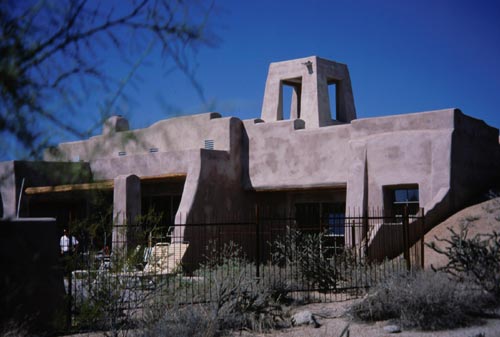 Evaporative cooling systems which utilize gravity effect on dense, cooled air to drop and spill into living spaces. The system is comprised of wet cooler pads mounted high in an area which provides no obstructions to air movement, which comes into contact with the pads. The warm dry air contacting the wet pads, cool and becomes more dense and heavier and falls down the tower, usually positioned over or adjacent to a major living space. The falling cool air, spills into the living space, pushing warmer out at strategic venting areas. As the process continues, the cooler air ponds in the area, providing a cool environment in Az. desert conditions.
Evaporative cooling systems which utilize gravity effect on dense, cooled air to drop and spill into living spaces. The system is comprised of wet cooler pads mounted high in an area which provides no obstructions to air movement, which comes into contact with the pads. The warm dry air contacting the wet pads, cool and becomes more dense and heavier and falls down the tower, usually positioned over or adjacent to a major living space. The falling cool air, spills into the living space, pushing warmer out at strategic venting areas. As the process continues, the cooler air ponds in the area, providing a cool environment in Az. desert conditions.
A variation to this system is the addition of a south facing thermal chimney to pull cool tower air through the house. Located at an opposite location from the cool tower, the thermal chimney provides an escape vent for interior warm air , which moves more quickly as it get heated and is driven out. This rapid venting has a drawing effect on the cool tower air and it is distributed more extensively through the building. The solar chimney can be set up to become a recirculating air heater during winter conditions.
Natural Cooling -
There are three sources of undesirable heat - direct summer sun solar gains through windows and glazing; heat transmission through the building envelope; and internal heat produced by people, their activities, and their equipment. Direct solar heat gain at windows and glazing can be easily controlled by shading the house - preventing the sun from reaching it (except for good day lighting and operation of solar equipment) and with external shading devices and vegetation as well as thermal insulating shutters. Heat transmission conditions can be nullified by setting up layers of thermal decompression with vegetation, built structure like porches, and water features. While there is not much that can be done to reduce natural heat production by people, equipment heat generation can be impacted by careful selection of energy efficient equipment and by good timing - do the laundry in the evening.
SOLAR COOKING


Use of the sun for food preparation is fun, energy saving, and saves money, both in the cooking operation, and in the cooling costs saved when the heat is taken out of the kitchen during the summer. A variety of cooking tools from box cookers to slat faced ovens are available - whether they be commercial products or hand built by the inspiring solar chef.
Passive Solar Energy has many faces and applications and an effective Passive solar building incorporates many of these elements. Natural processes and incorporation of building and site elements to provide for comfort as well as mitigation of untoward conditions are the hallmark of good passive design, and results in establishing a basis for reduction of equipment (solar and otherwise) for achieving comfort, and reduction of equipment purchase and operations costs. Passive solar energy is Direct,

This presentation was constructed by the Arizona Solar Energy Association for the Arizona Solar Center, Inc. under contract with the Arizona Dept. of Commerce Energy Office, funded by the Dept. of Energy Million Solar Roofs program. Materials and information were provided by a number of sources.
Financial support for this presentation has been provided by the Arizona Department of Commerce (Energy Office) and the U.S. Department of Energy through (DOE) Grant No. DE-FG51-01R021250. However, any opinions, findings, conclusions, or recommendations expressed herein are those of the author(s) and do not necessarily reflect the views of the Energy Office or U.S. DOE. The State of Arizona and U.S. DOE assume no liability for damages arising from errors, omissions or representations contained in this presentation.
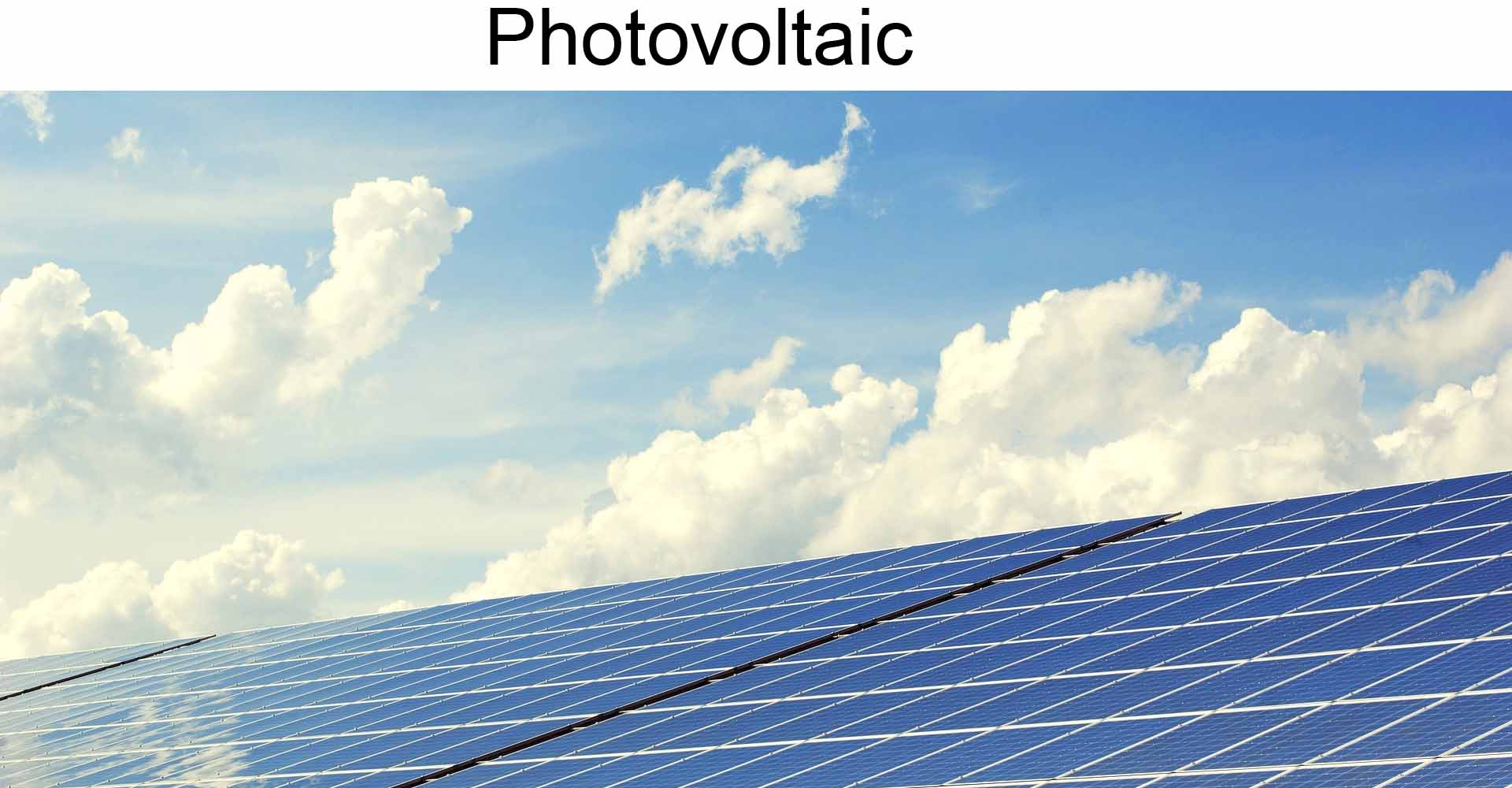
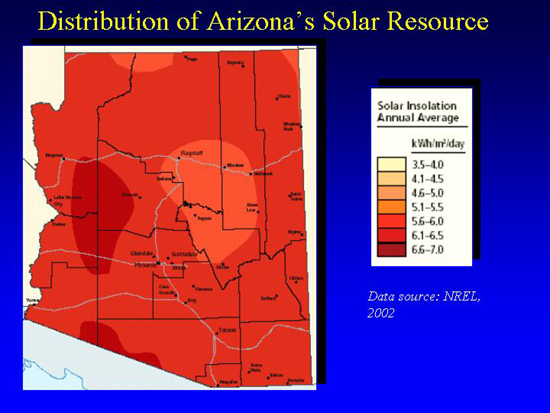

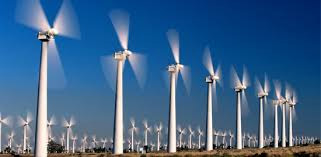
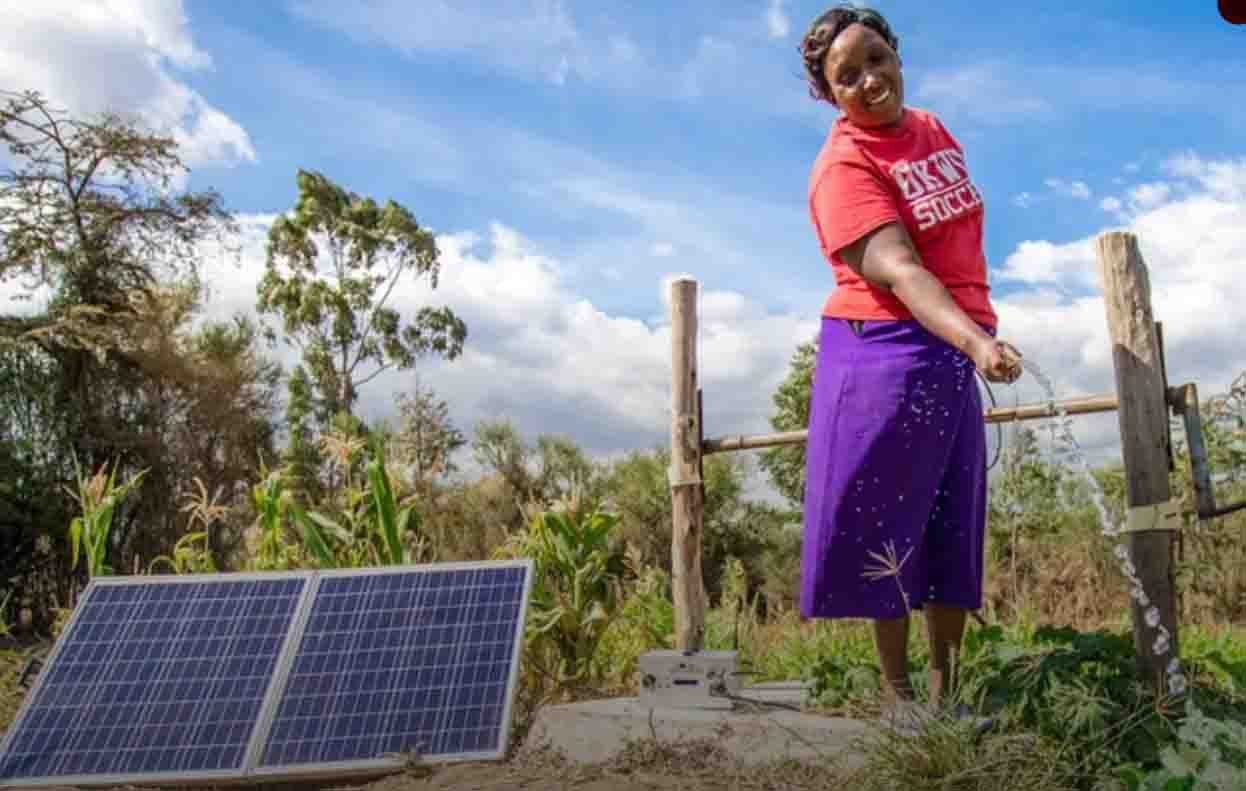

























































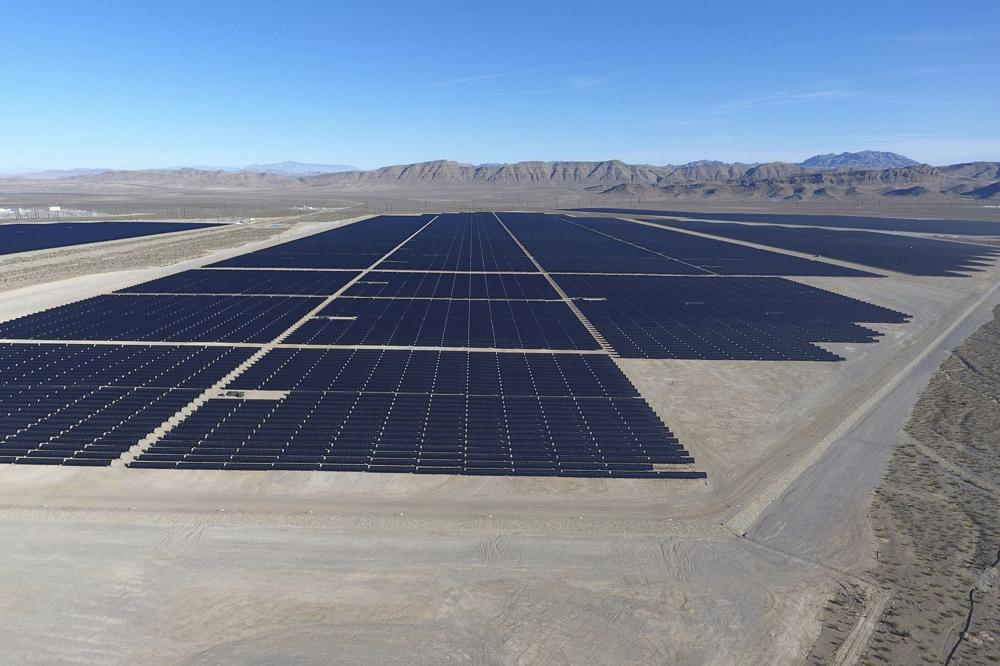
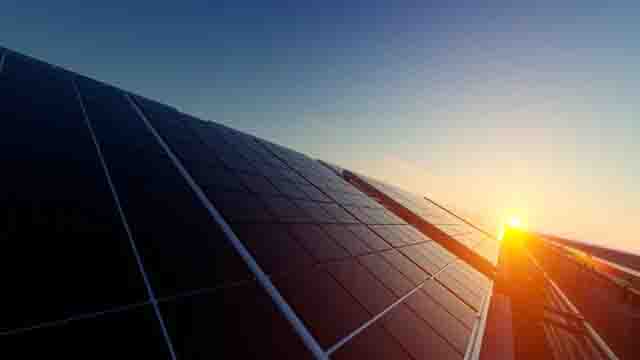

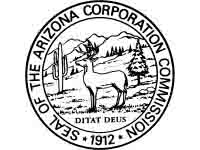



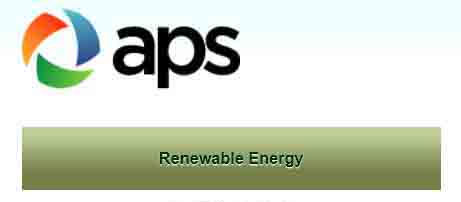
 APS has several large photovoltaic (PV) systems in the desert outside Gila Bend, Arizona. They are now adding energy storage systems to some of these PV systems. There is a good article about these on ABC15.com
APS has several large photovoltaic (PV) systems in the desert outside Gila Bend, Arizona. They are now adding energy storage systems to some of these PV systems. There is a good article about these on ABC15.com

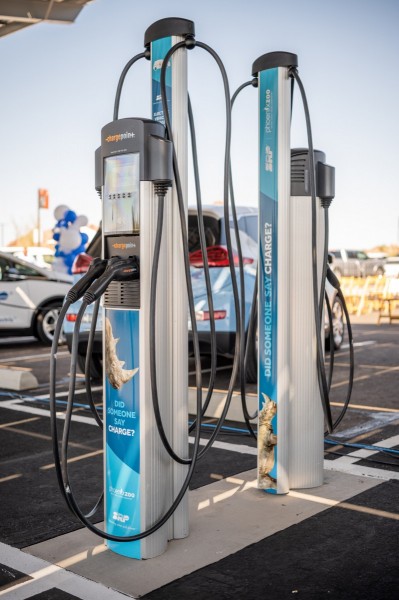


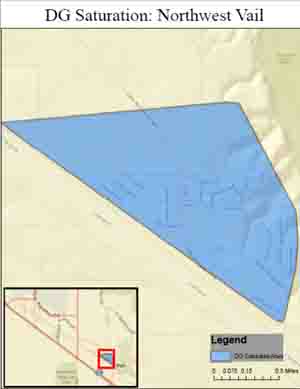

 Battery Storage Costs Drop Dramatically, Making Way to a New Era. A recent Rocky Mountain Institute (RMI) report continues to confirm that clean electrification through batteries is advancing at impressive rates. Very interesting report: Breakthrough Batteries- Powering the Era of Clean Electrification
Battery Storage Costs Drop Dramatically, Making Way to a New Era. A recent Rocky Mountain Institute (RMI) report continues to confirm that clean electrification through batteries is advancing at impressive rates. Very interesting report: Breakthrough Batteries- Powering the Era of Clean Electrification 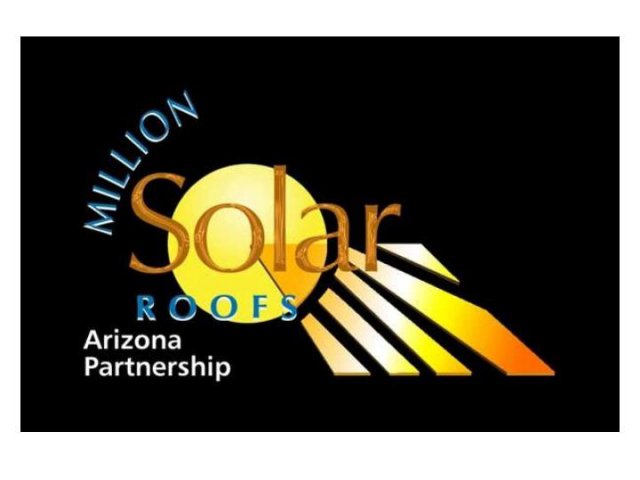
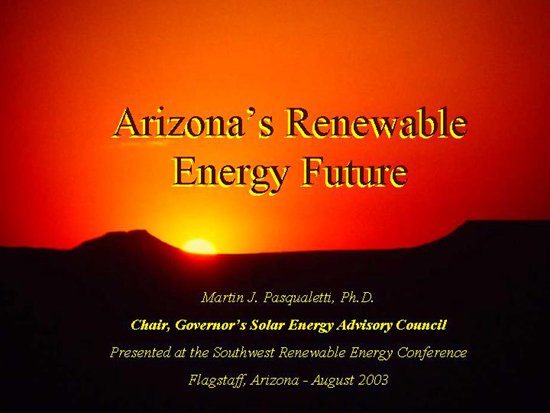

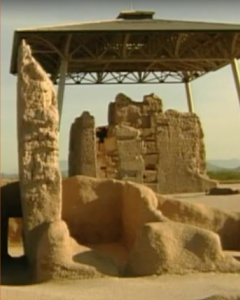
 A Checkered Past, A Bright Future
A Checkered Past, A Bright Future First Things First
First Things First
 Your Choices–An Overview
Your Choices–An Overview Bypass Valves
Bypass Valves Flat Plate Collectors
Flat Plate Collectors Evacuated Tube Collectors
Evacuated Tube Collectors Collector to Tank Interface
Collector to Tank Interface In climates where freezing occurs infrequently, a recirculation-type differential control will turn the circulating pump on when the collector inlet temperature falls to 40°F (4.4°C). The philosophy behind this design is that the cost of heating your collectors with hot water from your tank is low cost freeze protection if only required occasionally.
In climates where freezing occurs infrequently, a recirculation-type differential control will turn the circulating pump on when the collector inlet temperature falls to 40°F (4.4°C). The philosophy behind this design is that the cost of heating your collectors with hot water from your tank is low cost freeze protection if only required occasionally.
 ©1995 - 2001 Home Power magazine. All rights reserved.
©1995 - 2001 Home Power magazine. All rights reserved.
 Passive and Active solar applications should be considered as elements of the same palette - sort of the one-two punch of living with the sun,and the mutuality is undeniable. Both rely on the same design considerations of orientation, access to the sun, behavior of materials, and appropriate use of site resources, and vary only in the inclusion external energy of electricity and gas. Most active system guidelines even point out starting with passive considerations first.
Passive and Active solar applications should be considered as elements of the same palette - sort of the one-two punch of living with the sun,and the mutuality is undeniable. Both rely on the same design considerations of orientation, access to the sun, behavior of materials, and appropriate use of site resources, and vary only in the inclusion external energy of electricity and gas. Most active system guidelines even point out starting with passive considerations first.
 Traditionally, the term Passive Solar has been identified with heating and cooling of buildings, but it has a broader context and application. There is, of course passive solar heating and cooling of buildings. There is also passive solar water heating, solar cooking, natural lighting, passive solar heating of pools, and even passive solar devices which move things - equipment, air, etc. Even the process of direct conversion of sunlight to electricity can be considered a “passive” action since it occurs through the appropriate use and placement of materials and capitalizes on the behavior of the combinations created, without infusing man-made energy sources and machines to make it work.
Traditionally, the term Passive Solar has been identified with heating and cooling of buildings, but it has a broader context and application. There is, of course passive solar heating and cooling of buildings. There is also passive solar water heating, solar cooking, natural lighting, passive solar heating of pools, and even passive solar devices which move things - equipment, air, etc. Even the process of direct conversion of sunlight to electricity can be considered a “passive” action since it occurs through the appropriate use and placement of materials and capitalizes on the behavior of the combinations created, without infusing man-made energy sources and machines to make it work.




 We know the sun’s position every day of the year and the amount of radiation that position provides, both to the earth’s surface, as well as to various positions of building walls and/or equipment. A south facing wall, or piece of equipment gets more energy from the sun than any other position. An angle directly perpendicular to the sun gets more energy per square foot than one that is at an angle. The sun is less available in the winter (shorter days) than in the summer. There is less solar energy availability in the winter than the summer due to the sun’s position at an angle to the earth and therefore more atmosphere to penetrate.
We know the sun’s position every day of the year and the amount of radiation that position provides, both to the earth’s surface, as well as to various positions of building walls and/or equipment. A south facing wall, or piece of equipment gets more energy from the sun than any other position. An angle directly perpendicular to the sun gets more energy per square foot than one that is at an angle. The sun is less available in the winter (shorter days) than in the summer. There is less solar energy availability in the winter than the summer due to the sun’s position at an angle to the earth and therefore more atmosphere to penetrate.  Passive solar buildings are environmentally responsive and use nature’s elements in providing shelter and comfort to people in a manner that is healthy and minimally destructive of the environment; are non-depleting of natural resources; and use the building itself in the comfort creating process. They are characterized throughout the recent years with terms as “sustainable”, “renewability”, and “green”. Quite simply, these terms refer to the same thing - a nature incorporating , comfort generating, security providing environment in which the building composition itself is the “machinery” that creates protection, health and comfort, and incorporates appropriate solar equipment to attain higher degrees of performance.
Passive solar buildings are environmentally responsive and use nature’s elements in providing shelter and comfort to people in a manner that is healthy and minimally destructive of the environment; are non-depleting of natural resources; and use the building itself in the comfort creating process. They are characterized throughout the recent years with terms as “sustainable”, “renewability”, and “green”. Quite simply, these terms refer to the same thing - a nature incorporating , comfort generating, security providing environment in which the building composition itself is the “machinery” that creates protection, health and comfort, and incorporates appropriate solar equipment to attain higher degrees of performance.


 Arizona desert buildings, both private and public, used passive means of shading to provide respite from the intense sun. Passive solar equipment, in the form of water heaters, were prevalent in Arizona as well as Southern California. the historic Ellis-Shackleford House in Phoenix and the historic Tempe Bakery had direct gain solar hot water heaters.
Arizona desert buildings, both private and public, used passive means of shading to provide respite from the intense sun. Passive solar equipment, in the form of water heaters, were prevalent in Arizona as well as Southern California. the historic Ellis-Shackleford House in Phoenix and the historic Tempe Bakery had direct gain solar hot water heaters.





 Solar buildings employ a form and shape that is responsive to the elements of nature that impact upon it, as well as the solar equipment that is part of the passive/active solar approach. Elongated along the east west axis, an Arizona building optimizes the southern exposure for good wintertime direct heating, while minimizing the east and west exposures which are severely impacted negatively in the summer, especially in the Arizona desert areas. Good building form is also beneficial when it comes to integration of solar equipment. Instead of unsightly racks, collector panels can be blended into the building architecture, and seem as seamless as a skylight or clerestory window.
Solar buildings employ a form and shape that is responsive to the elements of nature that impact upon it, as well as the solar equipment that is part of the passive/active solar approach. Elongated along the east west axis, an Arizona building optimizes the southern exposure for good wintertime direct heating, while minimizing the east and west exposures which are severely impacted negatively in the summer, especially in the Arizona desert areas. Good building form is also beneficial when it comes to integration of solar equipment. Instead of unsightly racks, collector panels can be blended into the building architecture, and seem as seamless as a skylight or clerestory window. Location of a building and the placement of the spaces within are a critical passive element in optimizing the use of natural resources for comfort, and proper placement also optimizes integrated solar equipment by minimizing piping runs and complex plumbing and electrical transfers. 90% of the winter sun’s energy is received at the earth’s surface between 9 a.m. and 3 p.m. so open and continued exposure is important for natural heating. Habitable spaces that benefit from solar heating are best located on the south side of a building with support spaces (garage, storerooms, etc.) located to the perimeter and to the north side. In this way the sun can directly, or indirectly, provide it’s energy to warm the spaces which means less heating equipment.
Location of a building and the placement of the spaces within are a critical passive element in optimizing the use of natural resources for comfort, and proper placement also optimizes integrated solar equipment by minimizing piping runs and complex plumbing and electrical transfers. 90% of the winter sun’s energy is received at the earth’s surface between 9 a.m. and 3 p.m. so open and continued exposure is important for natural heating. Habitable spaces that benefit from solar heating are best located on the south side of a building with support spaces (garage, storerooms, etc.) located to the perimeter and to the north side. In this way the sun can directly, or indirectly, provide it’s energy to warm the spaces which means less heating equipment. Good location planning extends to the integration of solar equipment as a building component by reducing piping runs and the commensurate “line losses” , thereby allowing more of the solar heat captured in a water heating system to get to the storage and/or use point.
Good location planning extends to the integration of solar equipment as a building component by reducing piping runs and the commensurate “line losses” , thereby allowing more of the solar heat captured in a water heating system to get to the storage and/or use point.





 The sunlight received by a building will provide more than sufficient illumination to meet daily needs. Use of day lighting is a passive solar application. The sun’s capacity to provide light, when integrated correctly in a building, means no need to use artificial lighting during the day, which means no energy used for those lights, which means no utility cost, except at night when the sun doesn’t shine. Solar building design incorporates day lighting strategies of letting light into all spaces either directly with proper window placement, clerestories and even skylights, or indirectly with light reflecting color choices, light shelves, and transparent and translucent walls.
The sunlight received by a building will provide more than sufficient illumination to meet daily needs. Use of day lighting is a passive solar application. The sun’s capacity to provide light, when integrated correctly in a building, means no need to use artificial lighting during the day, which means no energy used for those lights, which means no utility cost, except at night when the sun doesn’t shine. Solar building design incorporates day lighting strategies of letting light into all spaces either directly with proper window placement, clerestories and even skylights, or indirectly with light reflecting color choices, light shelves, and transparent and translucent walls.  This glazing has dual benefit - while providing for illumination, it can also provide for wintertime heating. Good passive design then incorporates both attributes of sunlight - illumination and heating, and the building construction and finishes are used to capitalize on both. Light colored surfaces and transparent/translucent interior panels for “bouncing” or directing sunlight for illumination, and dark, thermal mass surfaces for absorbing the sun’s rays for heating. Multi-faceted and multi-applicable, day lighting design is an effective passive solar approach which has a direct impact on the building’s
This glazing has dual benefit - while providing for illumination, it can also provide for wintertime heating. Good passive design then incorporates both attributes of sunlight - illumination and heating, and the building construction and finishes are used to capitalize on both. Light colored surfaces and transparent/translucent interior panels for “bouncing” or directing sunlight for illumination, and dark, thermal mass surfaces for absorbing the sun’s rays for heating. Multi-faceted and multi-applicable, day lighting design is an effective passive solar approach which has a direct impact on the building’s Simply water in a tank within a container and exposed directly to the sun. This is the basis of batch/ breadbox, systems which combine collection, heating, and storage of water into a single component. Direct heating of the storage tank or tanks, makes this system compact, simple, and effective. These units are called a passive systems because they do not rely on equipment to make them function. When hot water is removed, it is replaced by an equal amount of "new" water.
Simply water in a tank within a container and exposed directly to the sun. This is the basis of batch/ breadbox, systems which combine collection, heating, and storage of water into a single component. Direct heating of the storage tank or tanks, makes this system compact, simple, and effective. These units are called a passive systems because they do not rely on equipment to make them function. When hot water is removed, it is replaced by an equal amount of "new" water. Hot water rises and cold water settles. This is because hot water is less dense than cold water due to its molecular "excitement" in being heated. In a typical water heater, colder water is at the bottom of a tank. When it is heated by the heating element or burner, it becomes less dense and rises to the top of the tank, while being replaced by cooler, settling water, which is, in turn heated, rises, etc.. This cycle is called a convective action. A thermosyphon solar water heating system incorporates natural convection to move fluid heated by the collector to a storage tank. In order to do this naturaly, the collector is located at some point below the storage storage tank. As the fluid at the bottom of the storage tank cools (more dense) it flows to the bottom of the collector where it is reheated making it rise back to the top of the storage tank. This process is continuous. As a result, thermosyphon systems do not need pumps and for that reason they are considered a passive system - that system that does not rely on equipment to make it function.
Hot water rises and cold water settles. This is because hot water is less dense than cold water due to its molecular "excitement" in being heated. In a typical water heater, colder water is at the bottom of a tank. When it is heated by the heating element or burner, it becomes less dense and rises to the top of the tank, while being replaced by cooler, settling water, which is, in turn heated, rises, etc.. This cycle is called a convective action. A thermosyphon solar water heating system incorporates natural convection to move fluid heated by the collector to a storage tank. In order to do this naturaly, the collector is located at some point below the storage storage tank. As the fluid at the bottom of the storage tank cools (more dense) it flows to the bottom of the collector where it is reheated making it rise back to the top of the storage tank. This process is continuous. As a result, thermosyphon systems do not need pumps and for that reason they are considered a passive system - that system that does not rely on equipment to make it function. Passive solar applications for heating and cooling a building mitigate expensive heating and cooling with conventional equipment driven by electricity and gas, and good passive design reduces the energy consumed and the allied cost of utility resources to maintain comfort.
Passive solar applications for heating and cooling a building mitigate expensive heating and cooling with conventional equipment driven by electricity and gas, and good passive design reduces the energy consumed and the allied cost of utility resources to maintain comfort. Heat capture, storage and distribution follow a natural and predictable behavior. Sunlight heats the surfaces it strikes. The amount of heat held within the material depends on the material composition - straw is a terrible holder, concrete is a better holder. When sunlight is no longer available the material gives its’ captured heat to adjacent cooler conditions.
Heat capture, storage and distribution follow a natural and predictable behavior. Sunlight heats the surfaces it strikes. The amount of heat held within the material depends on the material composition - straw is a terrible holder, concrete is a better holder. When sunlight is no longer available the material gives its’ captured heat to adjacent cooler conditions.




























 This is basically an indirect system where solar collection for heating are isolated from the living spaces, and while the system functions independently, heating can be called for by simply opening some floor vents and letting the natural behavior of hot air rise through the spaces. The most common application of this approach is the convective loop. Much like a thermosiphon water heater, heat transfer material of air or water, is moved across a collector panel system facing the sun, and circulated into a tank surrounded by rock (water transfer system) or a rock bin (air transfer system) in a continuous operating loop. Natural thermosiphoning occurs when the collector is lower than the heat storage area which is usually located under the building.
This is basically an indirect system where solar collection for heating are isolated from the living spaces, and while the system functions independently, heating can be called for by simply opening some floor vents and letting the natural behavior of hot air rise through the spaces. The most common application of this approach is the convective loop. Much like a thermosiphon water heater, heat transfer material of air or water, is moved across a collector panel system facing the sun, and circulated into a tank surrounded by rock (water transfer system) or a rock bin (air transfer system) in a continuous operating loop. Natural thermosiphoning occurs when the collector is lower than the heat storage area which is usually located under the building. Evaporative cooling systems which utilize gravity effect on dense, cooled air to drop and spill into living spaces. The system is comprised of wet cooler pads mounted high in an area which provides no obstructions to air movement, which comes into contact with the pads. The warm dry air contacting the wet pads, cool and becomes more dense and heavier and falls down the tower, usually positioned over or adjacent to a major living space. The falling cool air, spills into the living space, pushing warmer out at strategic venting areas. As the process continues, the cooler air ponds in the area, providing a cool environment in Az. desert conditions.
Evaporative cooling systems which utilize gravity effect on dense, cooled air to drop and spill into living spaces. The system is comprised of wet cooler pads mounted high in an area which provides no obstructions to air movement, which comes into contact with the pads. The warm dry air contacting the wet pads, cool and becomes more dense and heavier and falls down the tower, usually positioned over or adjacent to a major living space. The falling cool air, spills into the living space, pushing warmer out at strategic venting areas. As the process continues, the cooler air ponds in the area, providing a cool environment in Az. desert conditions.


 Arizona Solar Center Mission- The mission of the Arizona Solar Center is to enhance the utilization of renewable energy, educate Arizona's residents on solar technology developments, support commerce and industry in the development of solar and other sustainable technologies and coordinate these efforts throughout the state of Arizona. About the Arizona Solar Center- The Arizona Solar Center (AzSC) provides a broad-based understanding of solar energy, especially as it pertains to Arizona. Registered
Arizona Solar Center Mission- The mission of the Arizona Solar Center is to enhance the utilization of renewable energy, educate Arizona's residents on solar technology developments, support commerce and industry in the development of solar and other sustainable technologies and coordinate these efforts throughout the state of Arizona. About the Arizona Solar Center- The Arizona Solar Center (AzSC) provides a broad-based understanding of solar energy, especially as it pertains to Arizona. Registered